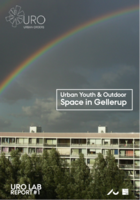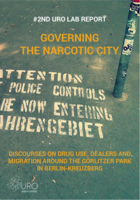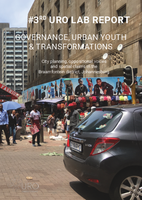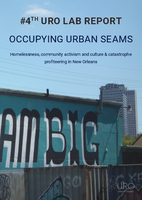
URO Lab Report #1: Urban youth and outdoor space in Gellerup
The 1st URO Lab was held in Aarhus 28-29 May 2015 and involved academics and practitioners from all collaborator cities except Johannesburg. The theme for the 1st UROLab was ‘Gellerup, youth and out- door spaces’. Focusing on the ongoing upgrading of the Gellerup Park on the western outskirts of Aarhus (the largest urban upgrad- ing project in Denmark), the aim of the 1st UROLab was for the participants to collectively discuss the contested status of the area’s urban youth in rela- tion to the use of outdoor spaces and, on this basis, consider new ways of har- nessing the Gellerup Park’s potentials for developing a more integrative urban environment. This report describes the 1st URO Lab from its in- ception and planning to the actual realization. It outlines main ndings and suggests ways of re n- ing our understanding of urban orders.
Download the report here.

URO Lab Report #2: Governing the narcotic city: discourses on drug use, dealers and migration around Görlitzer Park in Kreuzberg-Berlin
The 2nd UROLab was held in Berlin 26-28 May 2016 It focused on the contested urban orders of the Görlitzer Park - a public park in the neighborhood of Kreuzberg in Berlin Located in a diverse and rapidly gentrifying area between two vibrant nightlife districts, the Görlitzer Park continues to a ord a number of uses to a wide variety of groups, including migrants, bohemians, local families, tourists and drug dealers Recently, the park has become a key site for administrative and governmental interventions; not least caused by an increasing number of refugees using a space intended for recreational activities Consequently, in late 2014, the park was declared a “danger zone” with ensuing increases of patrols, raids and arrests Still, as both the marijuana trade as well as the protests against racial discrimination continue to escalate, the Görlitzer Park is currently the site of one of the hottest con icts of Berlin as well as a symbol for the ongoing struggle over public space and “the right to the city” This report describes the 2nd URO Lab from its inception and planning to the actual realization It outlines the main ndings and suggests ways of re ning our understanding of urban orders.
Download the report here.

URO LAB Report #3: Governance, Urban Youth & Transformations
The 3rd URO LAB was held in Johannesburg 2-4 November 2016. It had a focus on Braamfontein, a neighbourhood in downtown, populated by a multiplicity of people, among whom the students of Wits, University of Witwatersrand, are a significant group. Simultaneously a vibrant shopping area, campus and Business Improvement District, Braamfontein is witnessing a tension of gentrifcation, student protest and remnants of the racial segregation from former times. Just recently, Braamfontein has witnessed a clash between police squads and the #FeesMustFall-movement, protesting government legislation on education fees. The conflict has involved, directly or indirectly, a cluster of actors and stakeholders such as the Developer firm Liberty, the property owners South Point, the university itself, students, urban planners, local politicians and corporate investors, who all contribute to keep the neighbourhood in a constant tense state, where access to public space has become a complex issue, among others. The report follows the context and preparation of the URO lab, conclude the main findings and their consequence for the URO concerns. Also, this lab prompted reflections on the role of the researcher in an intensively politicized situation
Download the report here.

URO LAB Report #4: Occupying Urban Seams: Homelessness, community activism and culture & catastrophe profiteering in New Orleans
The 4th URO LAB was held in in New Orleans 10-12 April 2017. It explored liminal public spaces as a given condition overlaying New Orleans’ distinct urban neighborhoods. Focusing specifically on the Oretha Castle Haley Blvd. and the Central City neighborhood, the URO Lab used the socio-political and physical dynamics of the study area to investigate existing, changing, and potential ‘urban orders.’ The lab focused on the right to occupy public space, including use of ‘in-between’ spaces by the homeless and the intent of policing to facilitate conflicting use by ‘new users’ and encourage new development, alongside the use of public streets for traditional cultural practices such as music and performance associated with the Mardi Gras Indians in the face of the commodification of African American culture.
The Lab explored how New Orleans are characterised by gentrification, ‘catastrophe profiteering’, race-related conflicts around space including policing, cultural production including music and performance, and ‘street culture.’ Throughout the workshop, the questions who governs (the city), who profits (from urban development) and who produces (the city and urbanity) emerged as central elements in understanding the urban context of New Orleans. These issues are classical questions asked in urban studies when trying to make sense of the urban order and power relations in particular urban contexts. This report describes the 4th URO Lab from its inception and planning to realization. It outlines the participants’ observations and findings, and suggests how the dynamics of this case study might add to or alter our understanding of urban orders.
Download the report here.